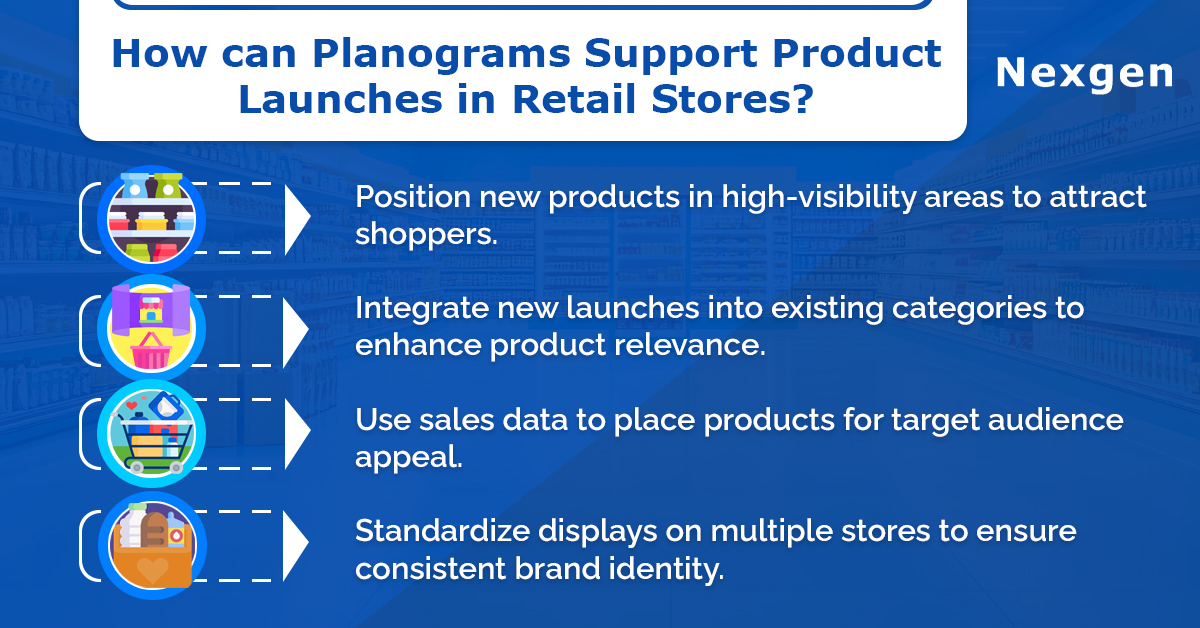Launching a new product in a retail store is an exciting yet challenging task. To ensure its success, strategic planning and effective merchandising are crucial. This is where planograms come into play. Planograms are visual representations of a store's product layout, designed to optimize the placement of items on shelves. Here is how they can significantly support product launches in retail stores.

1. Creating visibility for new products.
One of the most critical factors in a product launch is ensuring that customers see the new item. Shelf space planning help by strategically positioning products at eye level or in prime locations within the store. For example, a beverage brand launching a new flavor could use a planogram to place the product near popular choices or in a refrigerated section that customers frequently visit, ensuring it does not go unnoticed. By using planograms, retailers can:
- Place new products in high-traffic areas.
- Use endcaps, display stands, or designated launch zones to make new items stand out.
- Implement shelf signage, like "new product" tags, to draw attention.
2. Optimizing product placement for maximum engagement.
Product placement is key to driving curiosity and engagement. Planograms can help retailers and brands position new products in ways that encourage customers to pick them up, examine them, and, ideally, make a purchase. Some placement strategies include:
- Placing the new product near complementary items. For example, placing a new line of chips near popular dips can encourage customers to purchase both.
- If the product launch aligns with a theme such as ‘summer specials’ or ‘back-to-school', the planogram can place it alongside other relevant products for a cohesive shopping experience.
- Using planograms to place products near checkout counters or aisle ends for last-minute purchasing.
3. Encouraging sampling and trial with strategic placement.
Sampling is a proven way to drive interest in new products, especially in categories where customers may hesitate to try unfamiliar items. For example, a planogram can set aside space for a free trial pack of a new coffee blend, paired with the main display, to encourage customers to taste before they buy. Planograms support sampling strategies by:
- Allocating space for sample displays, testers, or trial sizes near the new product.
- Designing shelves to accommodate mini displays or sample stands without overcrowding.
- Integrating planogram layouts with customer flow to make sure sampling stations are placed in spots with high visibility and accessibility.
4. Ensuring consistency across multiple store locations.
For retailers with multiple locations, a consistent product launch experience across stores is essential for brand integrity. Planograms ensure that every store presents the new product in the same way, with unified branding, placement, and supporting materials. This consistency:
- Reinforces brand recognition and trust among customers who shop at different locations.
- Helps maintain consistent sales data to evaluate the success of the product launch across regions.
- Simplifies the setup process for in-store teams by providing a standardized layout, reducing setup time and potential errors.
Overview of Nexgen POG
Nexgen POG is a robust and user-friendly cloud-based visual merchandising tool. It is designed for quick and efficient planogramming with minimal effort. Planogram in retail can be designed by easily dragging and dropping the products. The multi-device compatibility feature of POG allows you to obtain, share and edit planogram on any device, including your phone. It helps in designing store-specific planograms for increased product visibility and sales.
Get Your Free Trial Now!